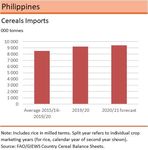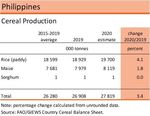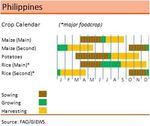GIEWS Country Brief The Philippines - ReliefWeb
←
→
Page content transcription
If your browser does not render page correctly, please read the page content below
GIEWS Country Brief
The Philippines
Reference Date: 07-April-2021
FOOD SECURITY SNAPSHOT
• Cereal production in 2020 forecast above five-year
average
• Above-average cereal imports forecast for 2020/21
marketing year (July/June)
• Pig population in 2020 decreased sharply due to
extensive outbreaks of African Swine Fever
• Prices of rice decreasing since June 2020; prices of
pig meat at high levels in first quarter of 2021
• Effects of COVID-19 pandemic increased poverty
Cereal production in 2020 forecast above
five-year average
Harvesting of the 2020 secondary paddy and maize crops is
underway and production prospects are generally favourable.
The ongoing October-May dry season has been characterized by
unusual high amounts of precipitation over most parts of the
country that, together with an adequate supply of irrigation water,
supported planting operations and had a positive impact on crop
development (see ASI map). Rainfall amounts in mid-January
were exceptionally abundant in Region VI (Western Visayas),
Region VIII (Eastern Visayas) and in parts of Mindanao Island,
causing localized floods and some damages to crops.
The harvest of the 2020 main paddy crop was concluded last
December and the output is officially estimated at record
11.1 million tonnes. Government support to production consisted
of provision of high-quality seeds, concessionary credit and
training. The 2020 June-October monsoon season was
favourable over most cropping areas, benefitting yields. Localized
crop losses were caused by heavy rainfall, strong winds and
floods following the passage of three consecutive typhoons
between late October and November 2020 over parts of the
Luzon Island and of the Region IV (Calabarzon). Overall, the
aggregate 2020 paddy production is forecast at 19.7 million
tonnes, 6 percent above the five-year average.
The 2020 main maize crop was harvested last September and
the output is estimated above the five-year average, reflecting
large plantings, supported by the steady demand of the feed
industry and above-average yields, following abundant monsoon
rains. Overall, the aggregate 2020 maize output is estimated at
8.1 million tonnes, 6 percent above the five-year average.
GIEWS global information and early warning system on food and agricultureAbove-average cereal import requirements forecast for 2020/21 marketing year (July/June) Aggregate cereal import requirements in the 2020/21 marketing year (July/June) are forecast at 9.4 million tonnes, well above the five-year average. Imports of wheat in the 2020/21 marketing year (July/June) are forecast at 6.2 million tonnes, slightly above the previous year’s high level due to sustained demand of high-quality wheat for milling and low-quality wheat for feed. Imports of rice in the 2021 calendar year are expected to reach 2.7 million tonnes, 10 percent more than in 2020. Maize import requirements in the 2020/21 marketing year are forecast at 900 000 tonnes, considerably above the five-year average, due to strong demand by the feed industry. Pig population decreased sharply in 2020 due to extensive outbreaks of African Swine Fever According to the Department of Agriculture (DA), as of mid-March, the African Swine Fever (ASF)1/ was present in 12 out of the 17 regions of the country and more than 3 million pigs have died or have been culled due to ASF. According to official information, the country’s pig population was estimated at 9.7 million animals in 2020, 25 percent below the 2019 high level and well below the five-year average. On 18 March 2021, the DA recommended to declare a national state of emergency in order to prevent a further spread of ASF. Prices of rice decreasing since June 2020; prices of pig meat at high levels in first quarter of 2021 Domestic prices of regular and well-milled rice have been steadily decreasing since June 2020, mainly reflecting improved market availabilities from the 2020 harvests and above-average imports. The prices of pig meat, the most consumed meat type in the country, soared between September 2020 and January 2021, reaching record levels in January, reflecting concerns about the impact of ASF on domestic production. Subsequently, pig meat prices showed signs of softening in February and March 2021 but remained 35 percent higher than a year earlier. Effects of COVID-19 pandemic increased poverty According to the Philippine Statistics Authority, the Gross Domestic Product contracted by 8.1 percent in 2020, after an average growth of 6.6 percent per year in the previous five years. The economic downturn resulted in widespread income losses, limiting the capacity of vulnerable households to purchase food. According to the World Bank, 25 million people (about 20 percent of the total population) were living in poverty in 2020, with an increase of 2.7 million people compared to 2019. _________________ 1/ African Swine Fever is highly contagious and lethal disease affecting pigs and wild boars. GIEWS global information and early warning system on food and agriculture
Disclaimer: The designations employed and the presentation of material in this information product do not imply the expression of any opinion whatsoever on the part of FAO concerning the legal status of any country, territory, city or area or of its authorities, or concerning the delimitation of its frontiers or boundaries. GIEWS global information and early warning system on food and agriculture
You can also read























































